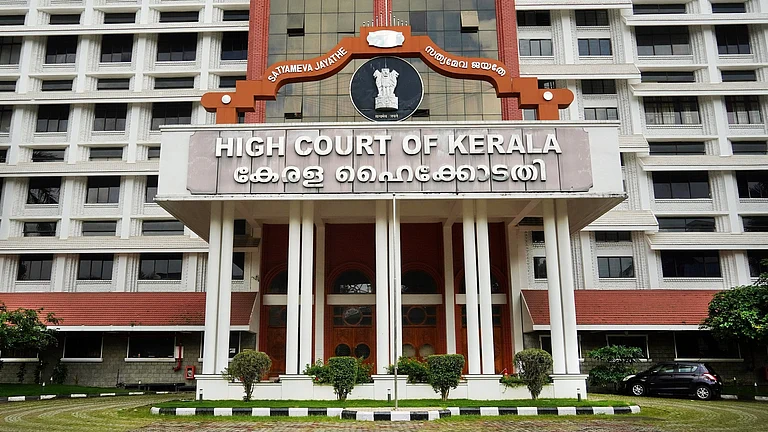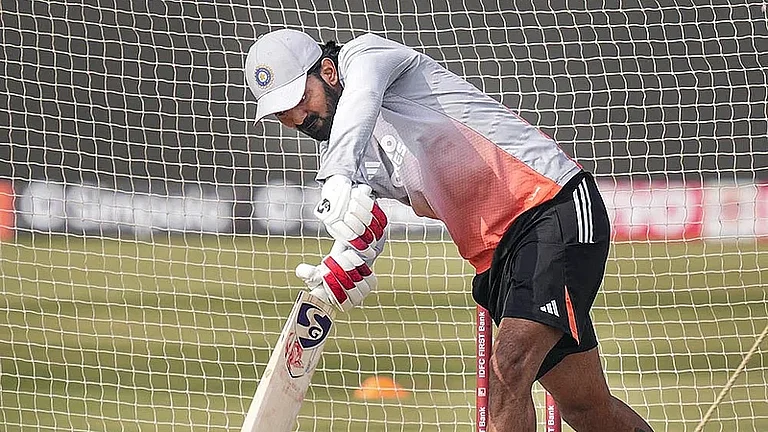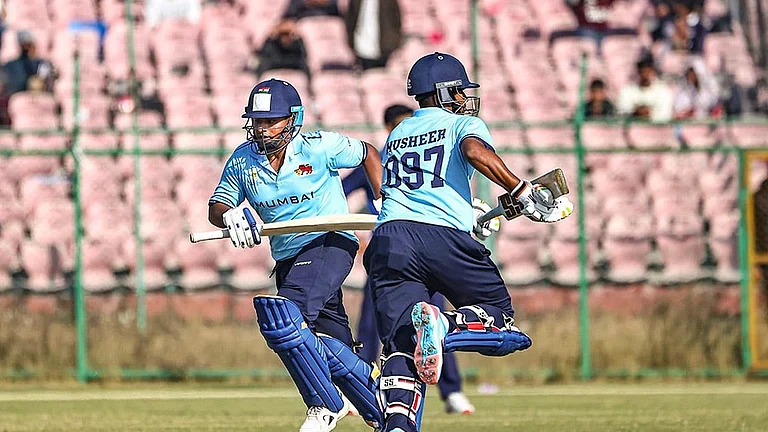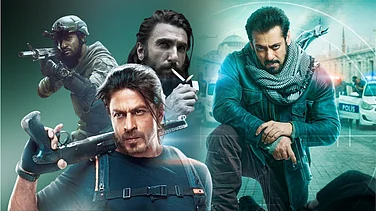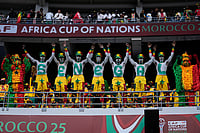IN 1975, Raghubir Singh, then a young Indian photographer taut with the excitement of first success, already sure of his gift but still uncertain of his art, went to meet Henri Cartier-Bresson, the reigning icon of modernist photography in Paris. Bresson was Singh's hero: a magic lens he had followed hungrily. Singh had discovered Beautiful Jaipur, a little known book published by Bresson in 49, as a schoolboy and had stoked his fire with it for years. Now he was to present Bresson with his own first two books. It was to be a grand moment of reckoning: the general would salute the footsoldier. But Bresson, intrinsically scornful of colour photography, barely flicked a page before pushing the books aside. Crushed, Singh redid his works. Today, 23 years later, the neuroses have been ironed out; the hero has fallen. As 56-year-old Singh sits talking about his oeuvre on the eve of his retrospective which starts on February 5 at the NGMA, Delhi, but has already been shown at the Bon Marche in Paris and the Art Institute of Chicago Bresson is but a passing mention: I wouldn't even bother to meet him now.
Stocky, ungregarious, yet widely considered an inspired pathfinder by admirers and critics alike, Raghubir Singh was the first to put Indian photography on the world map in the 1970s and among the first to introduce the concept of large format books on photography here. In fact, ever since Singh walked impulsively out of his graduation exam at Hindu College, Delhi, and was refused a job by the tea companies he applied to, photography has been his singular calling. At the core of this ravening passion (to which even his marriage to a Frenchwoman, Ann, fell victim) is Singh's belief in the idea of colour and the pictorial. Drawing intuitively from the rich ochres and burnished shades of his childhood in Jaipur, feeling it seep into his subconscious as he watched the passing of an era his father's Arab stallions being sold off, the family haveli falling to pieces Singh came to the understanding that everything, even sadness, in India is steeped in colour. Having understood this, Singh has consistently rejected the dark mood, the stark black-and-white images of western modernist photography and its sense of angst as alien to the Indian psyche; stuck to his moorings, even when colour photography was frowned upon by the international community as a prostitution of the profession.
In India, colour is the continuum of life itself, says Singh offering a 17th century painting from the Padshahnama which depicts the murder of Khan Jahan Lodhi against a picturesque setting of flowers and green as an example. Obviously excited by this idea, Singhs books are a treasury of incandescent colours shot mostly on 25 as a Kodakchrome. Whether he's capturing a resilient huddle of women against a damp wind lash in Monghyr, Bihar; a snaking line of pilgrims on the hard Himalayan path to Amarnath; or a funeral procession in Benares, Singh's pictures are always in colour evoking meanings and excitement for the viewer, not out of a symbolic play of black against white, but by capturing life in the act of living and recording colour as fact, not drama or touristy pageant.
The second key idea which underpins Singh's work and sets him apart is what he terms the democratic eye; the knowledge that one cannot isolate the decisive moment; that the spectacular, especially in India, happens in the context of the everyday. In Singh's frames then, men leap into the sky and dive arrowlike into the Ganges and women swing in wild abandon in a village in Rajasthan, but the moments of passion are always grounded in a disinterested flow of humanity in the background. Reminiscent of W.H. Audens poem Musee de Beaux Arts on Brueghel's Icarus. India is not exotic to Indians, says Singh, and his lenses bear out that refreshing viewpoint.
But for all his quick-fire intuition, Singh is strangely ponderous and slow to ignite. His erudition he's very well versed in both western and Indian art history and literature rings in the ears, at once compelling and overwhelming. But his un-ironic self-assurance is vaguely discomfiting: I stand remarkably alone, as did Satyajit Ray, Ritwik Ghatak, Naipaul and R.K. Narayan, says he, betraying no trace of humility or humour. Perhaps he needn't. With 12 published books and six in the offing, Singhs oeuvre can soon compare with their's. Besides it's probably this inviolate self-belief which has helped him achieve pre-eminence in the often unsympathetic world of western aesthetics. John Szarkowski, curator emeritus of the Museum of Modern Art in New York, apparently once dismissed his work saying India is so pictorial its easy to shoot. The museum would never show my work, confirms Singh, it would be like hanging a chandelier in their minimalist world!
Living in Hong Kong, Paris, and the US, Singh has shot for all the big journals National Geographic, The New Yorker, Time but these have only been support systems to fund his books, whose subjects have remained steadfastly Indian. Interestingly, Singh's contemporaries in India are quick to chorus their tributes to the seriousness of his undertaking, and the quality of his lens, especially in his early books on the Ganges, Benares, Calcutta and the Grand Trunk Road: He's a thinking photographer, he's taken the western tradition of street photography and given it a new non-western direction,' says Ram Rahman; He's a colour photographer of truly international class,' adds Sanjeev Saith; He has some very precious images,' agrees Raghu Rai. But the critical parentheses are quick to follow and debates about Singh's work are very heated, fuelled, it seems, in part by his reputed crustiness; and by what many consider to be the tapering quality of his recent work. He made the world of seeing so phenomenal, I envied him,' says Dilip Mehta, but now he's a fallen icon. The perceived fall is largely due to the fact that Singh has begun to use his frames as a dialogue with western aesthetics and art. And this leaves many viewers cold. A photograph should have the ability to live for itself beyond style, trend and colour, says Raghu Rai. Singhs work has gone beyond the level of responses like oh, lovely picture, explains Saith, but sometimes hes too dry for appreciation of the simple eye.
Too esoteric? Or merely veering dangerously close to the ordinary? The debate continues but Singh's ways of seeing have become more complex and layered. In his recent work, the drama of his earlier lens has given way to the presence of many fractured planes windows, mirrors, open doors with which Singh nuances and reinvents the ordinary. The loiterer, it seems, is no longer an amiable bystander, hes now looking for his place in art history. Finally, then, to the question many have been asking: why have a mid-career retrospective? Is this, as some suggest, a sign of a tired lens? Or is it just that Singh has deftly suspended his career for our musing, and is already moving on as David Travis, curator of photography, Art Institute of Chicago, says in the preface to Singh's retrospective album, River of Colour (Phaidon, £35).
I want to merge intuition with the thought out picture, says Singh of his new books, one of which will centre around the Ambassador car as form. Ironically, the River of Colour looks forward to this movement in Singhs work, the promise of a future flowering, a newer form. Whether that movement excites his audience or leaves them cold remains to be seen. Perhaps, it doesn't matter. Because, as Singh says of himself, he stands remarkably alone.







